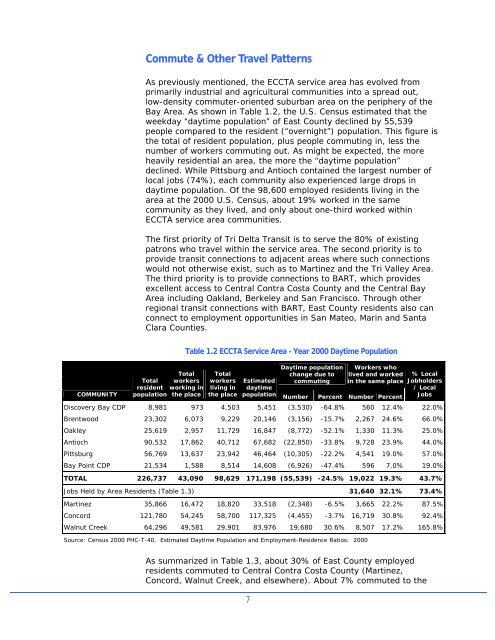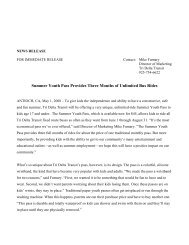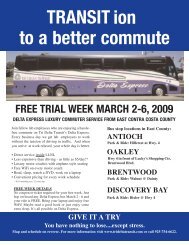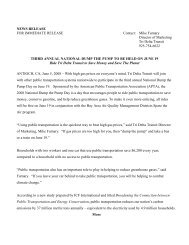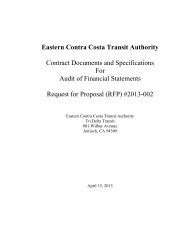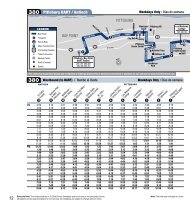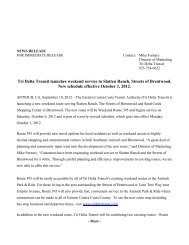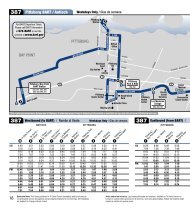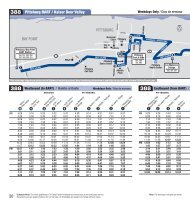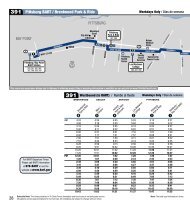to view Short Range Transit Plan FY 2007/2008 - Tri Delta Transit
to view Short Range Transit Plan FY 2007/2008 - Tri Delta Transit
to view Short Range Transit Plan FY 2007/2008 - Tri Delta Transit
You also want an ePaper? Increase the reach of your titles
YUMPU automatically turns print PDFs into web optimized ePapers that Google loves.
Commute & Other Travel PatternsAs previously mentioned, the ECCTA service area has evolved fromprimarily industrial and agricultural communities in<strong>to</strong> a spread out,low-density commuter-oriented suburban area on the periphery of theBay Area. As shown in Table 1.2, the U.S. Census estimated that theweekday “daytime population” of East County declined by 55,539people compared <strong>to</strong> the resident (“overnight”) population. This figure isthe <strong>to</strong>tal of resident population, plus people commuting in, less thenumber of workers commuting out. As might be expected, the moreheavily residential an area, the more the “daytime population”declined. While Pittsburg and Antioch contained the largest number oflocal jobs (74%), each community also experienced large drops indaytime population. Of the 98,600 employed residents living in thearea at the 2000 U.S. Census, about 19% worked in the samecommunity as they lived, and only about one-third worked withinECCTA service area communities.The first priority of <strong>Tri</strong> <strong>Delta</strong> <strong>Transit</strong> is <strong>to</strong> serve the 80% of existingpatrons who travel within the service area. The second priority is <strong>to</strong>provide transit connections <strong>to</strong> adjacent areas where such connectionswould not otherwise exist, such as <strong>to</strong> Martinez and the <strong>Tri</strong> Valley Area.The third priority is <strong>to</strong> provide connections <strong>to</strong> BART, which providesexcellent access <strong>to</strong> Central Contra Costa County and the Central BayArea including Oakland, Berkeley and San Francisco. Through otherregional transit connections with BART, East County residents also canconnect <strong>to</strong> employment opportunities in San Mateo, Marin and SantaClara Counties.Table 1.2 ECCTA Service Area – Year 2000 Daytime PopulationDaytime populationchange due <strong>to</strong>commutingWorkers wholived and workedin the same placeTotalresidentTotalworkersworking inTotalworkersliving inEstimateddaytime% LocalJobholders/ LocalCOMMUNITY population the place the place populationNumber Percent Number PercentJobsDiscovery Bay CDP 8,981 973 4,503 5,451 (3,530) -64.8% 560 12.4% 22.0%Brentwood 23,302 6,073 9,229 20,146 (3,156) -15.7% 2,267 24.6% 66.0%Oakley 25,619 2,957 11,729 16,847 (8,772) -52.1% 1,330 11.3% 25.0%Antioch 90,532 17,862 40,712 67,682 (22,850) -33.8% 9,728 23.9% 44.0%Pittsburg 56,769 13,637 23,942 46,464 (10,305) -22.2% 4,541 19.0% 57.0%Bay Point CDP 21,534 1,588 8,514 14,608 (6,926) -47.4% 596 7.0% 19.0%TOTAL 226,737 43,090 98,629 171,198 (55,539) -24.5% 19,022 19.3% 43.7%Jobs Held by Area Residents (Table 1.3) 31,640 32.1% 73.4%Martinez 35,866 16,472 18,820 33,518 (2,348) -6.5% 3,665 22.2% 87.5%Concord 121,780 54,245 58,700 117,325 (4,455) -3.7% 16,719 30.8% 92.4%Walnut Creek 64,296 49,581 29,901 83,976 19,680 30.6% 8,507 17.2% 165.8%Source: Census 2000 PHC-T-40. Estimated Daytime Population and Employment-Residence Ratios: 2000As summarized in Table 1.3, about 30% of East County employedresidents commuted <strong>to</strong> Central Contra Costa County (Martinez,Concord, Walnut Creek, and elsewhere). About 7% commuted <strong>to</strong> the7


